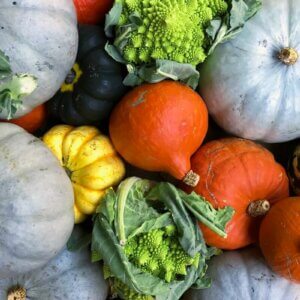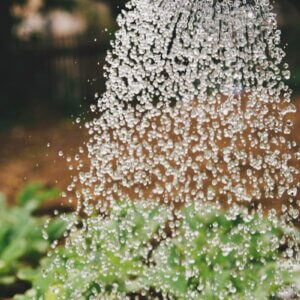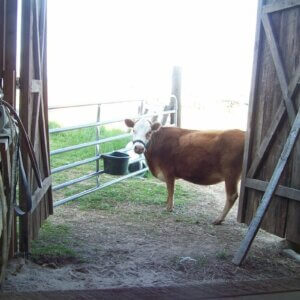Table of Contents
Considered a cruciferous vegetable, kale belongs to a group of cabbage cultivars originally grown in the eastern Mediterranean. Under the plant species of Brassica Oleracea, it grows in cold temperatures, making this leafy vegetable the star of many fall and winter recipes. Different types of kale come in unique colors and forms, all with distinct flavor profiles. However, commercially bought kale is among the top produce with the most pesticides.
Growing kale at home reduces exposure to these chemicals, ensuring organic harvest.
Take a deep-dive on these hearty greens and learn more about their heirloom and hybrid varieties below.
Common Kale Types
Before we classify kale plants based on color, texture, and other characteristics, these leafy vegetables can be separated into two categories.
Heirloom and Hybrid Kales
Heirloom varieties are essentially free from cross-breeding for at least 40 to 50 years. These types of kale are true to seed, carrying the same traits as the parent plant. Some heirloom kale plants are more vulnerable to disease and pest problems.

Out of human innovation came hybrid kale varieties. Intentional and manual crossbreeding is involved in creating hybrid kale varieties. Producing a permanent seed line isn’t the objective of crossbreeding two varieties as most hybrid seeds are sterile. Rather, it aims to improve the resulting hybrid with ideal traits from each parent, such as better resistance to cold, disease, or pests.
Other Popular Kale Groupings
Let’s take a look at the common kale varieties, classified according to their unique characteristics.
Types of Kale Colors
Kale comes in various shades of blue, green, purple, and red.
| Colors | Common Examples (Where to Buy) |
|---|---|
| Green Kales | Arun (Territorial Seed Company) Ethiopian (Territorial Seed Company, True Leaf Market) Portuguese (True Leaf Market, Rare Seeds) |
| Blue/Green Kales | Dazzling Blue (Territorial Seed Company, True Leaf Market, Rare Seeds, Burpee) Ebony (Territorial Seed Company) Winterbor (Territorial Seed Company) |
| Red/Purple Kales | Redbor (Territorial Seed Company) Scarlet (Eden Brothers, True Leaf Market, Territorial Seed Company, Rare Seeds, Burpee, Seed Savers Exchange) Kamome Series Purple (Eden Brothers, True Leaf Market) |
Types of Kale Textures
Other kale varieties are crisper than others.
| Kale Texture | Common Examples (Where to Buy) |
|---|---|
| Firm Texture | Dazzling Blue (Territorial Seed Company, True Leaf Market, Rare Seeds, Burpee) Red Russian (Eden Brothers, True Leaf Market, Territorial Seed Company, Rare Seeds, Burpee, Seed Savers Exchange) Dwarf Siberian (Eden Brothers, True Leaf Market, Rare Seeds) |
| Soft Texture | Lacinato or Nero di Toscana (Eden Brothers, True Leaf Market, Territorial Seed Company, Burpee) Sea (Territorial Seed Company) Premier (Eden Brothers, True Leaf Market, Burpee) |
Types of Kale Leaves
Kale varieties can also be classified according to the shape and size of their leaves.
| Kale Leaves | Common Examples (Where to Buy) |
|---|---|
| Curly Leaves | Blue Curled Scotch or Vates (Eden Brothers, True Leaf Market) Darkibor (Territorial Seed Company) Winterbor (Territorial Seed Company) |
| Feathery Leaves | Red Russian (Eden Brothers, True Leaf Market, Territorial Seed Company, Rare Seeds, Burpee, Seed Savers Exchange) Premier (Eden Brothers, True Leaf Market, Burpee) White Russian (True Leaf Market) |
| Bumpy/Flat Leaves | Black Magic (Eden Brothers, True Leaf Market, Territorial Seed Company, Burpee) Dazzling Blue (Territorial Seed Company, True Leaf Market, Rare Seeds, Burpee) Lacinato or Nero di Toscana (Eden Brothers, True Leaf Market, Territorial Seed Company, Burpee) |
Types of Kale Flavors
Knowing kale’s primary flavors will help you determine the right variety for your recipes.
| Kale Flavors | Common Examples (Where to Buy) |
|---|---|
| Sweet Flavor | Dwarf Siberian (Eden Brothers, True Leaf Market, Rare Seeds) Ethiopian (Territorial Seed Company, True Leaf Market) Siber Frills (Territorial Seed Company) |
| Mild Flavor | Autumn Star Kalettes® (Territorial Seed Company) Kale Microgreens (True Leaf Market) Redbor Kale (Territorial Seed Company) |
| Earthy/Bitter Flavor | Black Magic (Eden Brothers, True Leaf Market, Territorial Seed Company, Burpee) Chinese Hybrid (True Leaf Market) Blue Curled Scotch or Vates (Eden Brothers, True Leaf Market) |
Types of Kale Lifecycles
Most kale varieties are biennial plants, taking at least two years to complete its lifecycle. However, some farmers grow them as perennial plants.
| Kale Lifecycles | Common Examples (Where to Buy) |
|---|---|
| Annual Kales | Portuguese (True Leaf Market, Rare Seeds) Red (True Leaf Market) Starbor (Territorial Seed Company) |
| Biennial Kales | Blue Curled Scotch or Vates (Eden Brothers, True Leaf Market) Marrowstem (Seed Savers Exchange) |
| Perennial Kales | Kosmic (Territorial Seed Company) Sea (Territorial Seed Company) Walking Stick (Rare Seeds) |
Types of Geographic Origins
Kale originated in the Eastern Mediterranean and areas in Asia Manor.
| Geographic Origin | Common Examples (Where to Buy) |
|---|---|
| Mediterranean Kales | Lacinato or Nero di Toscana (Eden Brothers, True Leaf Market, Territorial Seed Company, Burpee) Scarlet (Eden Brothers, True Leaf Market, Territorial Seed Company, Rare Seeds, Burpee, Seed Savers Exchange) Thousandhead (Rare Seeds) |
| American Kales | Dazzling Blue (Territorial Seed Company, True Leaf Market, Rare Seeds, Burpee) Georgia Southern or Creole (Rare Seeds) Premier (Eden Brothers, True Leaf Market, Burpee) |
| Asian Kales | Chinese Kale Hybrid (True Leaf Market) Japanese Flowering (Rare Seeds) White Russian (True Leaf Market) |
Types of Culinary Uses
Kale is a well-loved leafy vegetable for its many culinary uses.
| Culinary Use | Common Examples (Where to Buy) |
|---|---|
| Kales for Salads | Blue Curled Scotch or Vates (Eden Brothers, True Leaf Market) Redbor (Territorial Seed Company) Winterbor (Territorial Seed Company) |
| Kales for Pestos/Dips | Darkibor (Territorial Seed Company) Lacinato or Nero di Toscana (Eden Brothers, True Leaf Market, Territorial Seed Company, Burpee) Winterbor (Territorial Seed Company) |
| Kales for Soups | Improved Dwarf Siberian (Territorial Seed Company) Red Russian (Eden Brothers, True Leaf Market, Territorial Seed Company, Rare Seeds, Burpee, Seed Savers Exchange) Scarlet (Eden Brothers, True Leaf Market, Territorial Seed Company, Rare Seeds, Burpee, Seed Savers Exchange) |
| Kales for Juicing | Dwarf Siberian (Eden Brothers, True Leaf Market, Rare Seeds) Kale Microgreens (True Leaf Market) Redbor (Territorial Seed Company) |
Types of Preferred Growing Conditions
Each kale variety has unique needs as shown below.
| Growing Conditions | Common Examples (Where to Buy) |
|---|---|
| Greenhouse Kales | Dwarf Siberian (Eden Brothers, True Leaf Market, Rare Seeds) Lacinato or Nero di Toscana (Eden Brothers, True Leaf Market, Territorial Seed Company, Burpee) Red Russian (Eden Brothers, True Leaf Market, Territorial Seed Company, Rare Seeds, Burpee, Seed Savers Exchange) |
| Field Kales | Marrowstem (Seed Savers Exchange) Thousandhead (Rare Seeds) Walking Stick (Rare Seeds) |
| Container Kales | Black Magic (Eden Brothers, True Leaf Market, Territorial Seed Company, Burpee) Blue Curled Scotch or Vates (Eden Brothers, True Leaf Market) Prizm (Territorial Seed Company, Burpee) |
Popular Varieties of Curly Kales

The curly kale is the most common type found in farmers markets or grocery stores. It is usually used in salad and stir-fry and topped on other dishes as decoration. Curly kales are characterized by the wavy or frizzy edges of the leaves and sturdy stems. To enjoy curly kale raw, you can massage it with citrus and olive oil, softening its fibrous stems.
| Variety | Description | Days to Germination | Days to Maturity | Where to Buy |
|---|---|---|---|---|
| Winterbor Kale | Winner of the Royal Horticultural Society’s Award of Garden Merit (AGM), the Winterbor kale is one of the most frost-hardy kale varieties. It is highly productive in yielding blue-green leaves ideal for salads. | 7 to 10 days | 60 days | Territorial Seed Company |
| Halbhoher Gruner Krauser Kale | This curly kale variety is ideal for container and greenhouse planting. At best, the Halbhoher Gruner Krauser grows 18 inches tall. | 3 to 10 days | 60 days | Seed Savers Exchange |
| Blue Curled Scotch or Vates Kale | The Blue Curled Scotch kale produces curly and tender leaves in a low-compact plant structure. | 7 to 14 days | 30 to 60 days | Eden Brothers, True Leaf Market |
| White Russian Kale | The White Russian gradually becomes sweeter after frost. This type of kale can tolerate both cold and hot temperatures. | 3 to 10 days | 50 days | True Leaf Market |
Popular Varieties of Italian Kales

Italian kales are the close relatives of the curly kale variety. They are a palmifolia variant, which has distinctly bumpy, flat leaves. Cooking them will reduce Italian kales’ rich flavor.
| Variety | Description | Days to Germination | Days to Maturity | Where to Buy |
|---|---|---|---|---|
| Lacinato or Nero di Toscana Kale | Also called Cavolo Nero in Italian (or black cabbage), the Lacinato kale is a famous heirloom variety. You can sow them in early spring or late fall. It has wider and bigger flat leaves than other varieties. Other names of this variety include Tuscan kale, dinosaur kale, or flat back kale. | 7 to 10 days | 30 to 60 days | Eden Brothers, True Leaf Market, Territorial Seed Company, Burpee |
| Thousandhead Kale | The Thousandhead is a multi-branching kale type, growing leaves as long as three feet. Cabbage worms and other caterpillars are easier to exterminate because the leaves are minimally curled. | 6 to 9 days | 50 to 60 days | Rare Seeds |
| Black Magic Kale | An improved variety of the Black Tuscan kale, the Black Magic has deep-shaded green leaves with uniform size and elongated shape. | 7 to 10 days | 30 to 60 days | Eden Brothers, True Leaf Market, Territorial Seed Company, Burpee |
| Ebony Kale | Ebony is a bolt-resistant lacinato type that grows as tall as 22 inches. Its leaves are slate-shaped with dark blue-green color. | 6 to 12 days | 62 days | Territorial Seed Company |
Popular Varieties of Russian Kales

Most Russian kales have arugula- and oak-like leaves with shades of dark green, gray, magenta, and purple. They can survive in intensely cold weather, even under minus 10 degrees Fahrenheit.
| Variety | Description | Days to Germination | Days to Maturity | Where to Buy |
|---|---|---|---|---|
| Red Russian Kale | Also known as Buda or Ragged Jack kale, the Red Russian is a resilient red variant of the popular Russian kale. Famous horticulturist Frank Morton cultivated this variety first in his home in Oregon. | 3 to 10 days | 50 to 70 days | Eden Brothers, True Leaf Market, Territorial Seed Company, Rare Seeds, Burpee, Seed Savers Exchange |
| Dwarf Siberian Kale | The Dwarf Siberian kale is ideal for salad and stir-fry. Growing anywhere between 12 to 15 inches tall, this cold-tolerant variety is a great option for container planting. | 3 to 10 days | 50 days | Eden Brothers, True Leaf Market, Rare Seeds |
| Ursa Kale | Mature leaves from Ursa kale are excellent additions to your slow-cooked stew or soup. It has wide, green to purple leaves and a magenta stem. | 7 to 10 days | 65 to 80 days | Burpee |
| Improved Dwarf Siberian Kale | The Improved Dwarf Siberian has larger frilled leaves full of flavor. It is a multipurpose kale type that goes well in salads, sandwiches, or soups. | 5 to 17 days | 50 days | Territorial Seed Company |
Popular Varieties of Baby and Microgreen Kales

Baby and microgreens are leaves harvested before maturity. Early culling suits some kale varieties better than others, and kale breeders have developed some varieties specifically for immediate consumption. If you’re curious about kale, try its baby or microgreen counterparts to gradually introduce it to your diet.
| Variety | Description | Days to Germination | Days to Maturity | Where to Buy |
|---|---|---|---|---|
| Vates Blue Scotch Curled Microgreens | Elevate your next baby salad by adding Vates Blue Scotch Curled microgreens. These leafy greens add a spinach-like flavor and thrive during cold seasons. | 2 to 3 days | 8 to 12 days (as baby or microgreen) | True Leaf Market |
| Ethiopian Kale | Originating from East Africa, the Ethiopian kale has sweet and mild flavor when harvested as baby greens. It has many names, including African kale, and Highland kale. | 5 to 15 days | 25 to 30 days (as baby or microgreen) | Territorial Seed Company, True Leaf Market |
| Kale Microgreens | The kale microgreens variety is famous for its fast germination rate. It offers a mild flavor with cabbage-like, sweet notes. | 1 to 2 days | 8 to 12 days | True Leaf Market |
| Red Kale | Red kale is an excellent option to grow as microgreen due to tender, and durable growth. When harvested, the young leaves can be tossed into your salad and eaten raw. The leaves come in a deep purple or red color from a compound called anthocyanins. | 7 to 10 days | 8 to 12 days (as microgreen) 20 to 25 days (as baby kale) | True Leaf Market |
Other Varieties of Kale
Some kale varieties are bred for their stunning foliage colors.
Popular Varieties of Ornamental Kales

You can beautify your garden with these vibrant kale varieties. Although they are edible, some people might find their flavor is not as appetizing.
| Variety | Description | Days to Germination | Days to Maturity | Where to Buy |
|---|---|---|---|---|
| Japanese Flowering Kale | The Japanese Flowering or Habotan kale features bright, colorful ruffles with hints of sweetness. Apart from its culinary purpose, this variety can be used for landscaping under cold climates. | 6 to 9 days | 85 days | Rare Seeds |
| Kamome Series | The Kamome Series variety grows “headless” dwarfed flowering kale. This ornamental plant comes in various colors, such as pink, red, white, or mixed. | 5 to 14 days | 91 to 98 days | Eden Brothers, True Leaf Market |
FAQ About Types of Kale
Which kale type is the best for juicing?
Any of the mild-tasting kale varieties are great for juicing. For example, Red Russian kale can be blended with avocado, citrus, and milk for a healthy, tropical smoothie.
Which kale type is the best for soups?
Among the varieties of kale, the Lacinato’s durable structure makes it the best option for soups. It has a chewy texture that softens when overcooked. The large leaves of this variety can soak up much of your soup for an enjoyable, tasty meal.










































Leave a Reply